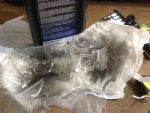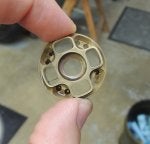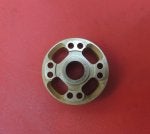Inspired by MGFChapin's How To thread on fork oil and seal change, I decided to try and tackle this on my 2012 675r mainly because I wanted to change to a lighter set of springs. I did not have to replace the seals.
Unfortunately, there wasn't any directly related info on this fork, surprisingly. So, through some trial and error, I managed to get through it, and honestly, it wasn't too bad.
I had posted onto MGF's original thread about some of the lessons and issues I had with the work; I hope folks w/ these same forks find it helpful... Bear in mind, this isn't really meant to be a step-by-step picture tutorial like MGF's (it was mainly just me doing the work, so I had no chance to readily snap pictures).
A quick note before getting started: I'm not particularly mechanically skilled--probably more like a shade-tree mechanic. What I do have, though, is time. Take your time, double check everything, and chances are your work will be as good as any shop. I was not under any time pressure to get the work done (i.e. not trying to get it done the night before a track day or race...).
Ok, let's do this:
FYI: On either fork leg, at the fork bottom on the inside face, there will be printed/stamped the specific model # of the fork, along w/ the manufacture date. Mine read FG9011 2011.10.07. So I know I have their FG9011 fork. Your fork may read differently, but odds are that it'll say FGXXXX on it, so these instructions should work.
TOOLS/MATERIALS NEEDED (assuming you have all the tools allowing the actual forks to be unbolted from the triple clamps):
http://ascycles.com/pdf/TriumphServiceSchedules/Triumph%20Data%20Sheet%20-%20Daytona%20675%20and%20675R%20from%20VIN%20564948.pdf
![Image]()
Quick pic of the fork partially disassembled. In order to change out the spring and oil, this is the level you will need to take it apart. You won't be messing with the NIX30 cartridge itself (which, BTW, requires a special tool to even remove--basically a long hollow socket w/ prongs at one end).
![Image]()
Home made inverted fork holder to drain oil:smile:; notice our inner fork tube is only 1/2 nitrided--undoubtedly to save some $$
![Image]()
Unfortunately, there wasn't any directly related info on this fork, surprisingly. So, through some trial and error, I managed to get through it, and honestly, it wasn't too bad.
I had posted onto MGF's original thread about some of the lessons and issues I had with the work; I hope folks w/ these same forks find it helpful... Bear in mind, this isn't really meant to be a step-by-step picture tutorial like MGF's (it was mainly just me doing the work, so I had no chance to readily snap pictures).
A quick note before getting started: I'm not particularly mechanically skilled--probably more like a shade-tree mechanic. What I do have, though, is time. Take your time, double check everything, and chances are your work will be as good as any shop. I was not under any time pressure to get the work done (i.e. not trying to get it done the night before a track day or race...).
Ok, let's do this:
FYI: On either fork leg, at the fork bottom on the inside face, there will be printed/stamped the specific model # of the fork, along w/ the manufacture date. Mine read FG9011 2011.10.07. So I know I have their FG9011 fork. Your fork may read differently, but odds are that it'll say FGXXXX on it, so these instructions should work.
TOOLS/MATERIALS NEEDED (assuming you have all the tools allowing the actual forks to be unbolted from the triple clamps):
- FORK CAP OR TOP REMOVAL TOOL. I purchased mine from Kyle Racing--you will want his BLACK-colored 4 pronged tool. Alternatively, you could also look up "adjustable pin wrench spanner"; Dave Moss I believe uses a Facom model, which by the time you purchase the actual pins that fits, will likely cost more than the Kyle tool (but would allow you to use on other Ohlins fork top models)
- CARTRIDGE PULL UP TOOL. Again, bought mine from Kyle Racing.
- >1 L FORK OIL. Technically changing our the fork oil should take just <1L, but you will want to have some extra in case you mess up. Our forks specify Ohlins 1309 fork oil; I had purchased Maxima 5W fork oil prior to knowing this, but checking the oil comparison table here: https://transmoto.com.au/comparative-oil-weights-table/ shows that Ohlins 1309 has a cST of 19, whilst the Maxima 5W is 15.9. I doubt I'd be able to notice this difference, so I went ahead and used what I purchased anyhow.
- VISE TO CLAMP FORK IN while not absolutely necessary, is very helpful.
- MOTION PRO OIL LEVEL TOOL http://www.motionpro.com/motorcycle/partno/08-0121/
- AN EXTRA PAIR OF HANDS. I had to have my wife help me with at least 2 steps per fork leg--compressing down the spring to allow me to undo the lock-nut that held the spring top down and vice versa. Dave Moss' video has him doing this himself, and my fingers were not strong enough to do this while simultaneously getting a 17mm wrench on the nut (perhaps also because I did not have a dedicated fork vise available).
- YOU DO NOT NEED THE RACETECH OR SIMILAR FORK SPRING COMPRESSOR. Our Ohlins FG forks w/ the NIX30 does not have a hole/slot at the bottom of the fork leg to fit the Racetech tool, nor does it have a plastic sleeve w/ holes at the top of the spring to help w/ spring compression. I ended up using some nylon rope looped around the coils of the spring and my wife's help to compress the spring--this was the hardest part of the job, and honestly, Ohlins could have made life a helluva lot easier. Theoretically something like this http://www.traxxion.com/Fork-Spring-Compressor Kit-4017/ would've worked, but I never did try it...(you can find them cheaper on Ebay)
- Dave Moss' OTT video: http://www.onthethrottle.com/product/ohlins-road-track-fork-service-howto-video/ He works on a FG R&T Ohlins fork, which is basically the same as ours (our fork lowers are cast, R&Ts are billet). THIS IS THE SINGULAR MOST HELPFUL VIDEO AND WELL WORTH THE $4.99 HE CHARGES. There is nothing like seeing a high quality video, much better than still pictures.
- SportbikeTrackGear's video on installing some Ohlins 30mm NIX cartridges into a R1 fork
http://ascycles.com/pdf/TriumphServiceSchedules/Triumph%20Data%20Sheet%20-%20Daytona%20675%20and%20675R%20from%20VIN%20564948.pdf
- Recommended fork oil Kayaba KHL 15-10 (SAE 5W) or Ohlins fork oil (assumed to be 1309)
- Oil volume (dry fill) 476cc per fork leg
- AIR GAP (fork fully compressed, spring and lower spring spacer removed) 150mm

Quick pic of the fork partially disassembled. In order to change out the spring and oil, this is the level you will need to take it apart. You won't be messing with the NIX30 cartridge itself (which, BTW, requires a special tool to even remove--basically a long hollow socket w/ prongs at one end).













